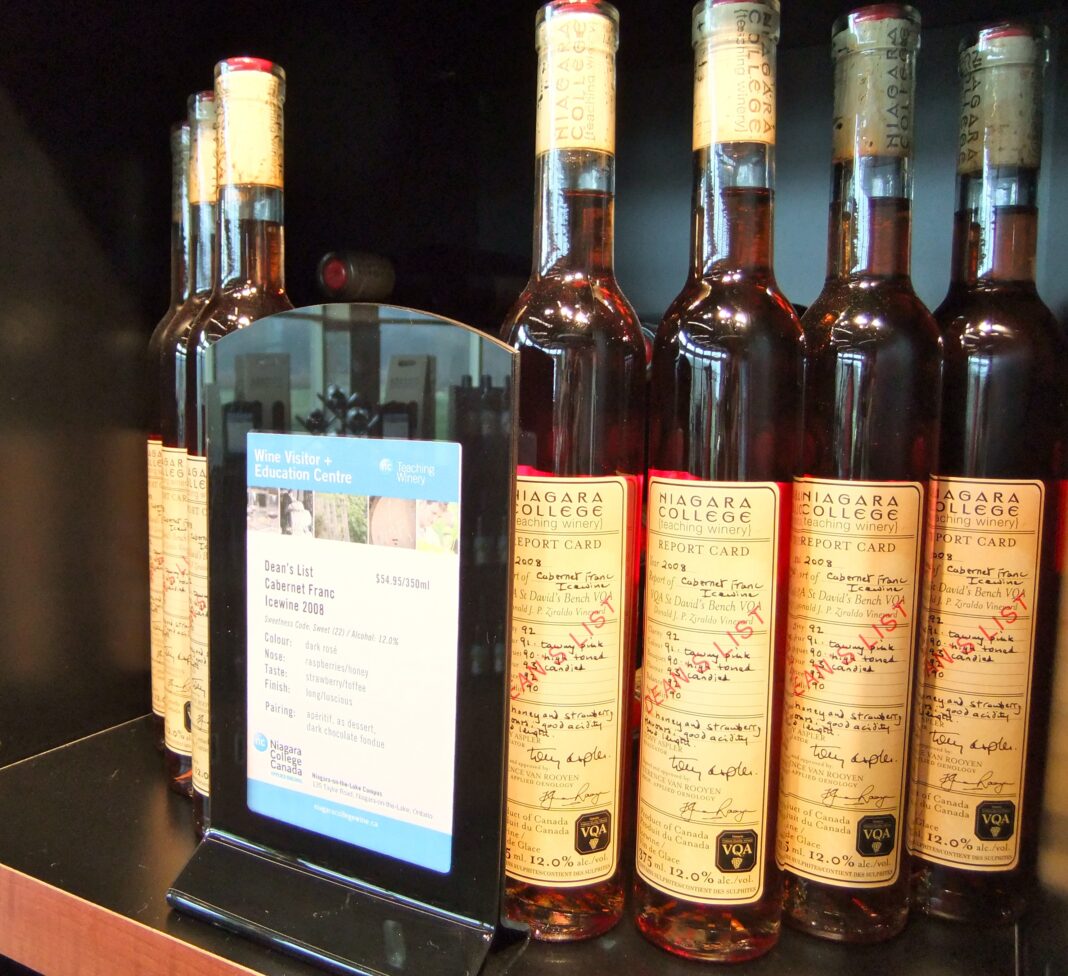Ice Wine Is Timeless
Savor The Goodness Of Grapes
Often referred to as Eiswein in German, Ice Wine is a type of dessert wine made from grapes that have frozen while still on the vine. However, sugar and other solids dissolved do not freeze, but only the water content in the grapes. This allows for a more thickened grape juice to develop.
It also results in obtaining a smaller amount of concentrated sweet juice when frozen grapes are pressed. The freezing eventually happens before the fermentation process with ice wines. However, ice wine grapes should not be affected by Botrytis cinerea or noble rot, as it does in other dessert wines made from Sauternes, Tokaji, or Trockenbeerenauslese grape varieties.
It is not enough to have an absurd amount of sugar in the wine to be recognized as the finest. Balance is the key and natural acids should concentrate as well. Not every variety or climate can do that.
Only healthy grape varieties keep the ice wine procedure in good shape until the excuse arises for an ice wine harvest. In extreme cases, this usually occurs after the New Year on a northern hemisphere calendar. It gives the characteristic refreshing sweetness to ice wine balanced by high acidity.
Grapes that are free of Botrytis are said to have come ‘clean’. They happen to deliver a very complex and sweet wine. Most ice wines are made from the grapes like Cabernet Franc, Cabernet Sauvignon, Riesling, or Vidal. But there are ice wines made from Merlot, Sangiovese, and Shiraz as well.
Producing Ice Wine
Production of ice wine can be risky. There are times when frost may not come at all before the grapes rot. The availability of a large labor force to pick the whole crop within a few hours is also required at short notice. This usually depends on the first morning that is cold enough as the grapes for ice wine must only be harvested when they are naturally frozen and the temperature must be around minus 8 degrees Celsius or below when they are picked. Most often this results in a relatively small amount of ice wine being produced worldwide. It is this factor that typically makes ice wines so expensive.
What is so special about Ice Wine?
Ice Wine is a very sweet wine as the water freezes within the grapes. However, the sugars and other dissolved solids within grapes do not crystalize. This happens to create a wine that is even sweeter than most sugar-filled sodas.
Ice wine is a perfect wine for special occasions. They are full-bodied due to their syrupy consistency. They display a rich liquid golden hue. Despite being lower in alcohol than most other dessert wines, ice wines at 10 percent ABV are deeply indulgent.
Squeezing frozen grapes into small sweet concentrations is a technique dating back to ancient Roman traditions. Germans have known it as a homegrown delicacy since the late 18th century. This style seems to have caught on in the 1970s in North America. It was sparked by a German citizen in the Okanagan Valley in Canada.
Ice wine in a way gave farmers a chance to save their crops after an unforeseen frost. Fewer winemakers in those days left grapes on the vine after harvest. It was because a cold snap could not be counted or assured to come on.
Future Of Ice Wine
Germany now is the second-largest producer of ice wine worldwide after Canada. The warm winter in 2019 left an unprecedented situation when all but one harvest failed due to global warming. It drastically decreased the chance of harvesting ice wine grapes at minus 8 degrees Celsius over the past 10 years as per the findings of the German Wine Institute.
Nevertheless, ice wines age beautifully and can be preserved for decades in case climate change continues its course. Ice wines in such circumstances will become extremely rare or may be unavailable if producers are no longer able to make them. It is already so expensive as prices are rising. So this may be a perfect time for you to squirrel away a bottle or two, as ice wines are commonly sold before it is too late.
Top Global Ice Wine Brands
- Dr. Loosen Riesling: Ice wine in Germany today is normally produced from riesling grape vineyards usually located in the southwestern Mosel region of the country. Dr. Loosen’s is a characteristically light and gentle ice wine yet complex on the nose and palate. It comes along with notes of apple, honey, and Melo. Dr. Loosen Riesling makes for that perfect bottle to set aside to age. You can always break it open in a few years for celebrations.
- Inniskillin Vidal: Located in Niagara-on-the-Lake, Inniskillin is the leading producer of ice wine in Canada. And Inniskillin Vidal is a great introduction to the style. It comes with aromas offset by solid natural acidity and tropical fruit tastes. Inniskillin is fast becoming an ice wine aficionado. This winery is also offering a sparkling wine version and another aged ice wine in oak.
- Peller Estates Signatures: This red ice wine from Peller Estates also comes from the Niagara region in Canada. It is made of 100 percent cabernet franc. Alongside the expected taste from the grape variety, Signatures feature flavors of bold red berries, pomegranate, and rhubarb. Ice wines generally tend to pair well with desserts and spicy cuisine. Peller Estates Signatures is no exception and is a great candidate for pairing with cheeses and salty olives.
- Weingut Max Ferdinand Richter Mülheimer Helenenkloster Riesling: This German winery produces old-school rieslings in style. Sommeliers believe that Weingut Max Ferdinand Richter is one of the top ice wine producers in the country. You can expect hearty, deep flavors with Mülheimer Helenenkloster Riesling. This ice wine particularly comes with notes of caramel and licorice alongside a smoky finish and sherry on the nose. It goes very well on the palate along with the lingering sweetness of traditional ice wines.
- Dr. Pauly-Bergweiler Noble House: This ice wine also hails from the Mosel region in Germany. Thanks to the weather conditions Dr. Pauly-Bergweiler had the good fortune to be able to produce great ice wines in 2016 and 2018. These ice wines generally tend to be mellow. And Noble House is especially crisp and zesty. It comes along with flavors of exotic fruits and smoky mineral notes.
- J.J. Prüm Bernkasteler Johannisbrünnchen: This is one of the most reputable wineries in Germany. J.J. Prüm is also located in the Mosel region. After 400 years it is still run by the Prüm family. However, its wine list changed forever in 2004 when it produced the last ice wine. Bernkasteler Johannisbrünnchen is obviously a splurge but worth every drop. Thanks to its splendid balance and vibrancy moored in lush citrus flavors, this ice wine is probably one of the best sweet wines you can ever get to taste.
Ice Wine Health Benefits & Side Effects
As per experts, Ice Wine is healthier than other alcoholic beverages. Here are some primary reasons they cite.
- Ice wines normally have slightly lower alcohol content than regular table wines. Quite a few Riesling ice wines from Germany have an alcohol content as low as 6 percent.
- Ice wines contain more antioxidants including flavonoids, phenolic compounds, tannins, vitamin C, and vitamin E. They also have trace elements of manganese, selenium, and zinc. Ice wine has the potential to eliminate free radicals in the body. It is anti-aging, anti-bacterial, and anti-cancer.
- Consuming ice wine can lower the blood pressure. It has a protective effect on the cardiovascular system alongside reducing the risk of myocardial infarction.
- Selenium found in ice wine empowers the immune system in the body. It also has anti-cancer properties.
Reasons to Avoid Ice Wine
Incidentally, ice wine winemakers make it a point to leave those resilient grapes on the vine for birds, bees, and wild beasts. They lose almost 90 percent of yield because of this. Rather than making some dry wine, some perverted winemakers are willing to risk it all.
The requirement for ice wine by Croatian wine law is a maximum of minus 7 degrees Celsius or colder temperature for three days in a row. Maybe you can obtain just 10-20 percent of liquid juice because of this. Then there are many presses that break under the pressure of squeezing such grape varieties. This procedure should really be called a raisin harvest.
Side Effects of Drinking Wine
Wine is likely safe for most adults when orally consumed in moderation. This is about two 5-ounce glasses daily. However, larger amounts are possibly unsafe and can cause blackouts, drowsiness, trouble walking, vomiting, and other serious problems.
Large amounts of wine consumption can cause many serious long-term health problems including dependence, certain types of cancer, and liver problems.
Moreover, there isn’t enough reliable information available to know if wine is safe or devoid of side effects when applied to the skin.
Why is Ice Wine So Expensive?
Ice wine production is limited to a minority of the wine-growing regions in the world where the required cold temperatures can be expected. Canada, followed by Germany is the largest ice wine producer in the world. It produces a greater volume of Ice Wine than all other countries put together.
Price sensitivity and ice wine can hardly fit into the same bracket. Every wine newbie wonders why is ice wine so expensive.
This is largely because of the extreme yield loss and painfully delicate fermentation process that can take months when compared to days or weeks for regular wines. The aging process and the fact that almost no juice can be squeezed from the frosted raisins also matter. Eventually, the price of Ice Wine is extravagantly high. This is why the bottle size of ice wine most often is usually half of the regular bottle and is still pricey.










